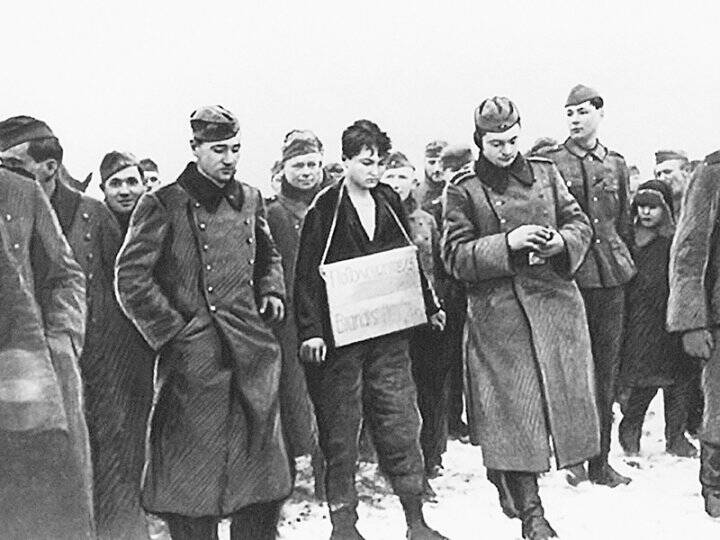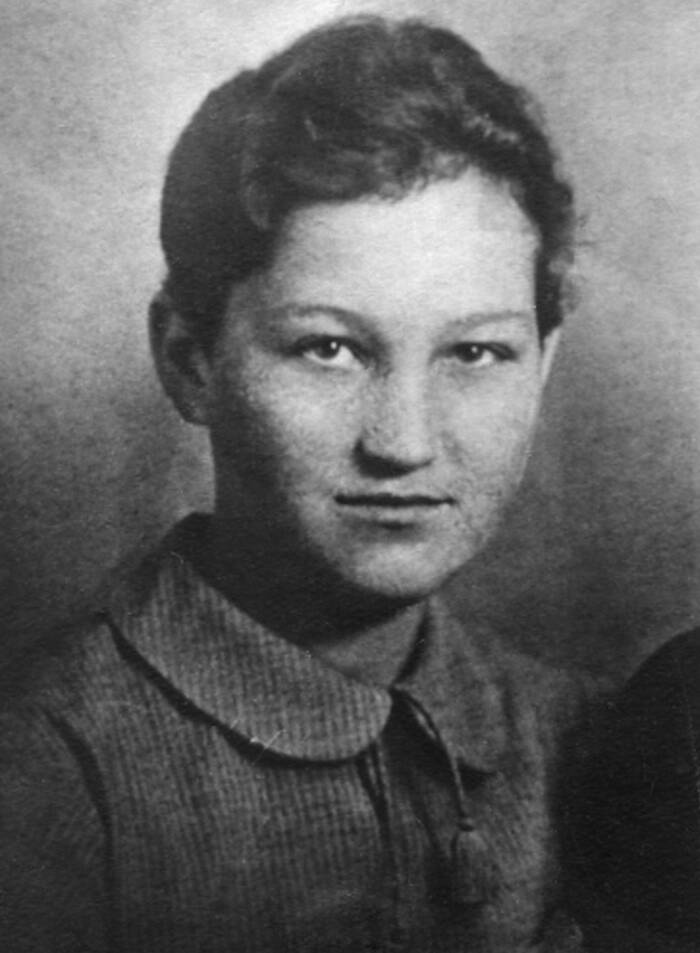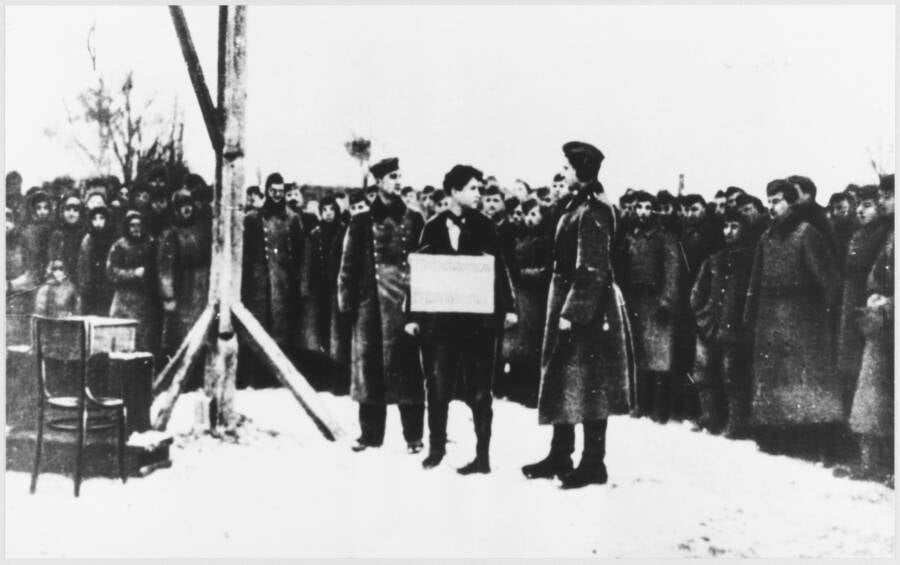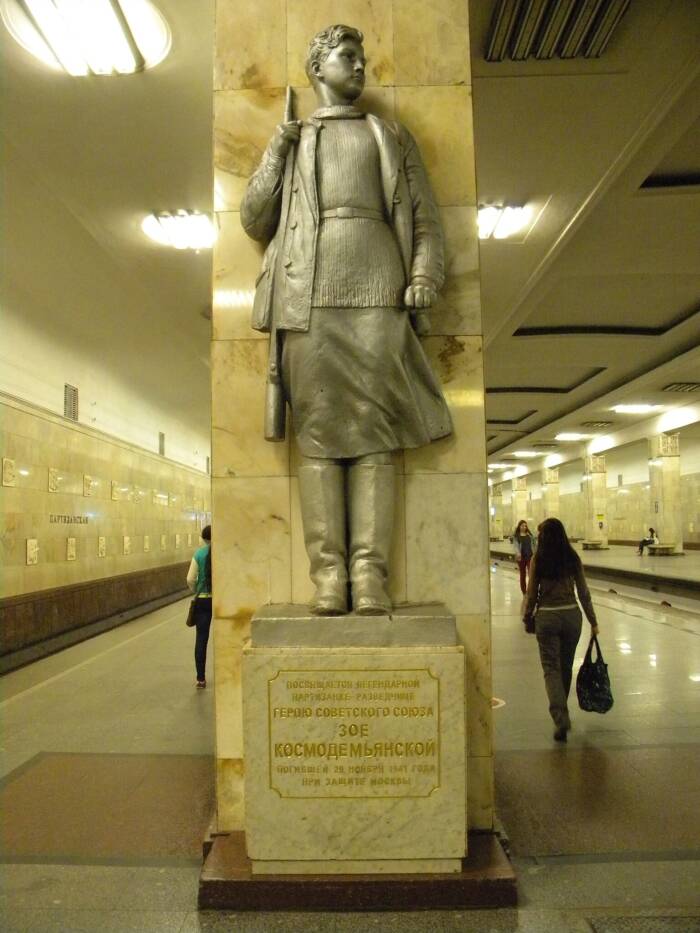In 1941, 18-year-old Zoya Kosmodemyanskaya was executed by German troops after she gave her fellow resistance fighters one final rallying cry: "I’m not afraid to die, comrades. It is happiness to die for one’s people!”

Unknown, 1943The alleged execution of Zoya Kosmodemyanskaya in Petrischevo.
During World War II, word spread throughout the Soviet Union of a brave young schoolgirl named Zoya Kosmodemyanskaya. It was said that when Germany invaded the country in 1941, Kosmodemyanskaya volunteered in a guerilla army to fight back, cutting German telephone wires and setting fire to buildings being used by Nazi officers.
When she was finally caught, she refused to give her German captors any information and was eventually executed. Her show of defiance even in the face of torture and death led her be lauded as a martyr and a “Hero of the Soviet Union.” After her death, she joined the ranks of history’s most legendary resistance fighters and woman warriors, and her story became synonymous with Soviet resilience.
But some have since questioned whether her story was even true.
The Early Life Of Zoya Kosmodemyanskaya
Zoya Kosmodemyanskaya was born in September 1923 in Osinovye Gai, not far from Moscow. According to Russian media, she came from a long line of priests. Her father Anatoly, however, never finished his studies at the seminary. Instead, he married Lyubov Timofeevna, the daughter of a clerk. They both worked as teachers.
Kosmodemyanskaya was described as a “friendly and trusting” child who would greet every passerby with a smile. She was so sweet that people often compared her to an angel.

Wikimedia CommonsZoya Kosmodemyanskaya, the Soviet hero.
Then, in 1929, collectivization began, a policy in which the Soviet government took control of individual pieces of agricultural land and converted them into collective farms. Years before, Anatoly’s father had been murdered by a mob because he had criticized leaders of a peasant rebellion, claiming they were not advocating for the poor but those who simply didn’t want to work.
Perhaps fearing persecution, Kosmodemyanskaya’s family moved to Siberia and, after a few more moves, ended up in Moscow. Anatoly got a job at an agricultural university, and Lyubov worked as a school teacher.
Tragically, Anatoly died under suspicious circumstances in 1933 when Zoya was very young, leaving her widowed mother Lyubov to raise Zoya and her brother Alexander on her own.
As a student, Zoya became involved in Communist youth organizations, first as a Pioneer, then as a member of Komsomol. It was this indoctrination as a Soviet partisan that would help make Zoya Kosmodemyanskaya a household name in Russia for decades to come.
A Soviet Rebel Is Born
In June 1941, Adolf Hitler began his march on the Soviet Union. This was Germany’s largest invasion effort during World War II and one of the largest in history, involving 80 percent of Germany’s armed forces and more than three million troops. Many Soviet civilians were killed or taken prisoner.
Such events didn’t escape the attention of Zoya Kosmodemyanskaya, then a 10th grader at the 202nd Secondary School in Moscow. She promptly decided to drop out of school to fight in a guerrilla army.
TIME reports that at the age of 18, Kosmodemyanskaya enlisted in an intelligence school, chopping her hair and donning men’s clothes. She soon performed a number of heroic feats. Kosmodemyanskaya cut the wire of German field telephone, set fire to German quarters, and destroyed a 20-horse German stable.
Then, in the winter of 1941, she was tasked with burning down part of the village of Petrisheva, where some German soldiers were reportedly stationed. Germany allegedly captured her in the midst of this arson attempt. But despite torturing her for hours, they couldn’t get her to talk or even give her real name. Instead, she insisted her name was “Tanya.”
They punched her, beat her with a leather belt, held lit matches up to her skin, forced her to walk barefoot through the snow for hours, and scraped her back with a saw. But they couldn’t break her.
“Kill me, I won’t tell you anything,” she allegedly said.
So the Germans sent her to the gallows.
The Death Of Zoya Kosmodemyanskaya

Chronicle / Alamy Stock PhotoA Soviet partisan believed to be Zoya Kosmodemyanskaya is sent to the gallows.
When the Germans couldn’t get Zoya Kosmodemyanskaya to reveal Soviet intelligence, they decided to make an example out of her. On Nov. 29, 1941, they hung a card reading “Guerrilla” around her neck and marched her to the Petrisheva village square. As villagers watched in terror, the officers led the young woman to the gallows and lowered a noose over her neck.
“Comrades!” Kosmodemyanskaya reportedly shouted. “Cheer up! Smite the Germans! Burn them!”
Then, she addressed her captors.
“You hang me now,” Kosmodemyanskaya said, “but I am not alone. There are 200,000,000 of us. You won’t hang everybody. I shall be avenged. Soldiers! Surrender before it is too late. Victory will be ours.”
As her captors tightened her noose, Kosmodemyanskaya stood on tiptoes to shout her final farewell: “Goodbye, Comrades!”
At the age of just 18, Zoya Kosmodemyanskaya was dead.
News Of Zoya Kosmodemyanskaya’s Heroism Spreads
After her death, news spread of Zoya Kosmodemyanskaya’s final act of bravery.
According to the Russian outlet SMI, a local newspaper published a story called “Tanya” by Pyotr Aleksandrovich Lidov in 1942. The essay tells of “Tanya’s” execution at the hands of the Nazis alongside a photo of the young woman’s mutilated body. But at the time, no one knew the girl’s real identity.
“In early December 1941, in Petrishchevo, near the city of Vereya,” Lidov wrote, “the Germans executed an eighteen-year-old Komsomol member from Moscow, who called herself Tatyana… She died in enemy captivity on a fascist rack, without making a single sound, without betraying her suffering, without betraying her comrades. She accepted martyrdom as a heroine, as the daughter of a great people that no one can ever break!”
Lidov added: “May her memory live forever!”
Allegedly, Kosmodemyanskaya’s friends recognized her in the photo and came forward to reveal Tanya’s identity. Soon, Kosmodemyanskaya was lauded as a hero. It’s said that when he learned of her final act of defiance, Joseph Stalin himself said, “Here is the people’s heroine.”
On Feb. 16, 1942, she was declared “Hero of the Soviet Union.” Her brother received the same distinction after he died while fighting in the war. Kosmodemyanskaya soon became a symbol of Soviet resistance and heroism. In the years after her death, streets and squares throughout Russia were named for her and monuments were erected in her honor. Her image and story were frequently used in anti-German and pro-Soviet propaganda.
But recently, there has been some doubt as to whether events really played out like this — or if the martyred rebel was even Kosmodemyanskaya at all.
Her Complicated Legacy Today

Tothkaroj/Wikimedia CommonsA statue of Zoya Kosmodemyanskaya at the Partizanskaya metro station.
In the 1990s, a series of essays published in the Russian newspaper Arguments and Facts called Zoya Kosmodemyanskaya’s story into question.
In one of these essays, a journalist claimed to have spoken with residents of Petrishchevo, who claimed that there were no German officers in the village when Kosmodemyanskaya set it on fire. Instead, Kosmodemyanskaya had been participating in a Soviet “scorched earth” policy to deter the Germans.
According to this essay, it was not German soldiers who captured and hung Kosmodemyanskaya but Petrishchevo villagers, enraged after she attempted to burn down their homes.
Allegedly, after Kosmodemyanskaya’s death, Soviet troops arrived and took some of the villagers away, leaving those who remained too afraid to speak out about the truth behind the national hero.
In response to these allegations, some came forward with alternative theories. One historian said that it was Lilya Azolina, another partisan woman, and not Kosmodemyanskaya who performed the feats she was credited with. Allegedly, Azolina’s friends and mother had also identified her from the photo of “Tanya.”
Another article revealed documents showing that Kosmodemyanskaya had once been registered at a psychoneurological dispensary. They suggested that her defiant silence may have actually been a result of “mutism,” a symptom of schizophrenia that renders one unable to speak in certain settings.
These allegations were met by many throughout Russia with shock and rage. Some tried to discredit them, calling them a second execution of the Soviet hero.
But with conflicting evidence and few records of her life, it may be impossible to know the truth of Zoya Kosmodemyanskaya and whether she was really the Russian martyr many learned about.
Whether or not she existed though, it’s sure that her story inspired generations of Soviets. Today, she remains a revered hero.
After reading about Soviet hero Zoya Kosmodemyanskaya, read about Milunka Savić, history’s most decorated woman soldier. Then, learn about the legend that inspired the Disney movie “Mulan.”





